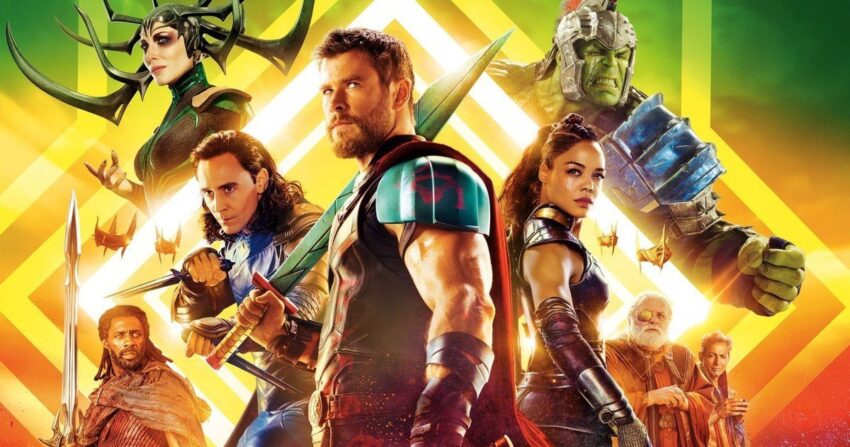We’ve talked a lot about tone on the blog lately. Whether you’re trying to manage a darker, more serious story without being overly violent, or if you want to balance a lighter story with higher stakes, managing your story’s tone is a multifaceted topic that requires a combination of several tools to do well. Although in my article on One Piece I mentioned many of the tools you can use to ensure your tone does not become too dark, those are only a few of the options. There are many more — definitely too many to cover in one article.
And one I didn’t mention was how the very setup of your conflict — and how you structure the series of events leading up to the climax in particular — determines a lot about your story’s tone, even without directly altering its stakes, characters, or content at all.
So to explore that today, we’re going to be looking at Thor: Ragnarok, a movie whose tone makes it immediately stand out among the other films in Thor’s saga. Despite boasting of higher stakes, greater consequences, and more drastic tragedy than any of its predecessors, the movie pulls off a surprisingly bright and upbeat tone.
And the reason for that is all in how the writers structured the movie’s plot.
Thor: Ragnarok
Thor: Ragnarok is set as the third installment in Thor’s saga within the Marvel Cinematic Universe and the lead-up to his entrance into the final battle of Infinity War and Endgame. Arriving back to his home country of Asgard after being imprisoned in another dimension, Thor finds the throne has been taken over by his brother Loki, while his father — the rightful king — is nowhere to be found. Amid the chaos, an old legend is rumbling through Asgard, promising its doom as foretold in the prophecy “Ragnarok.” Despite everything Thor has done to prevent it, the death of his father and the arrival of his older sister, Hela, is now inevitable — and she will bring with her the destruction of Asgard.
Thor and Loki first face her on a Norwegian cliffside, where she quickly overpowers both of them and banishes them to a far-flung planet where Thor is captured and forced to compete as a gladiator. There, surrounded by warriors used to fighting to survive, Thor realizes he may have a chance of gathering allies to challenge Hela. He even finds Hulk, his friend and ally, who has been missing for nearly two years. Together with Val, an elite warrior from ancient Asgard, and Loki, who agrees to put aside their differences to take back their home, they finally succeed in escaping the planet and reaching Asgard, where Hela has already begun her reign of terror.
But a small resistance still stands, and together with Thor, they rally together for one final stand in an attempt to take back Asgard and restore their people’s civilization.
Thor: Ragnarok and Tone
I have a lot of beef with Thor: Ragnarok. From the assassination of Thor’s character, his inexplicable breakup with the central love interest (which happens off screen), to cheap humor that damages every moment that could have had an impact on the viewer, I could write a few different articles on this movie. In some ways, it seems to be the precursor of the downfall of Marvel’s tone and charming humor in the same way that Captain Marvel was the precursor for the destruction of its female characters. Because, despite the massive consequences of the movie, Thor: Ragnarok lacks the cinematic, block-buster tone of most of the Marvel movies preceding it, as well as the first two installments in the Thor saga. Those movies rang with the echoes of the West’s classic Epics, with heroes facing incredible challenges and somehow managing to conquer them.
In contrast, Thor: Ragnarok has a more carefree, chipper tone than you would expect from a big-budget action movie. And this is despite the fact that thousands (or more) of innocent people died, a queen of witchcraft and hell destroyed an entire civilization, and the protagonist lost his home forever. And this isn’t due to the protagonist (who can’t stop making jokes), the villains (which are constantly mocked and laughed at), or a few of the genuinely funny characters who get their quips in, as well (such as Loki.) Like we talked about in November, those moments rarely actually lighten the tone, instead mostly coming across as forced. You could definitely have all those elements and still manage a tone that at least attempted the blockbuster-esque tension to be expected from Marvel movies like this one.
But Thor: Ragnarok didn’t, and I think it highlights another tool we as writers can have in our toolbox when attempting to master a lighthearted tone that accompanies more serious stakes. And it all has to do with the plot.
From gladiator fights to dramatic Norwegian cliff sides, the setting of Thor: Ragnarok is a bit all over the place. The movie opens to a fire demon’s prison, and yet most of it takes place on a chaotic and free-spirited planet splattered with color. The central problem of defeating Hela and taking back Asgard often takes the back seat as Thor’s more immediate needs shift from surviving capture to calming an enraged and violent Hulk.
This isn’t always a bad thing. Having your characters fight more immediate threats while larger, more central conflicts loom in the background can be done well. But it fundamentally alters your book’s tone.
Plots like this ring of the sort of stories parents tell their children at bedtime, where each night a new problem arises for the protagonist and is quickly resolved, only to be replaced with a new obstacle, preventing him from reaching the ultimate conflict until the very last chapter of the story. This creates the illusion of stories like Thor: Ragnarok being lighthearted and bright in tone, even when in reality violence is common, many people die, and the ultimate result of the story is devastating.
This is in sharp contrast to other movies, such as Thor’s first, which (according to its premise) would seem to have a far more lighthearted tone. It doesn’t seem like both having a protagonist who is essentially an overpowered teenager struggling with arrogance and writing the main conflict as whether or not he can pick up a hammer would make for the kind of blockbuster tone the movie was going for. Much of the conflict is smaller, and more personal — a far cry from the cosmic consequences from Thor’s actions in Ragnarok.
But because the tension in that first movie was concentrated and dealt with obstacles that most immediately arise from the central conflict around Thor’s pride, the movie is able to have the sort of blockbuster tone the writers were looking for.
This illusion arises from the fact that the audience of any story will judge the importance of a conflict by how long the protagonist actually spends dealing with it. Since Thor only spent about twenty minutes of the movie facing Hela (rather than fighting to get to her), she seems like the kind of conflict that would take twenty minutes to resolve. Despite the fact that he actually admits he can’t defeat her and she’s so powerful that the only way to stop her is to destroy Asgard along with her, it feels like Thor reaches this conclusion surprisingly quickly. On the other hand, if Thor had spent the movie’s entire two-hour runtime trying and failing to defeat her, over and over again, this conclusion would have not only seemed more founded, but also made for a more serious tone.
Contrast this with Thor’s first movie, in which takes almost the entirety of the story either setting up for or taking down his own pride. He spends a whole movie trying to subdue the conflict, giving it the blockbuster tone that arises from long-fought and hard-won battles that take entire movies (or in our case, entire books) to resolve.
But not every book or movie is meant to have that kind of tone. Some of my favorite stories are the ones like One Piece, DuckTales, and 100 Days of Sunlight, which are powerful stories with high stakes and bright tones. So if you want to write a story like that — with tension sky-high and a tone as bright and cheerful as you can manage — use this tool to make it that way. You can avoid a serious blockbuster tone by giving your protagonist a series of problems that are heavy and important while still being distant from the central conflict. Just because Thor: Ragnarok fumbled with its tone doesn’t mean your story has to. Set up your conflict strategically, and you can use it to leverage your book’s tone like an expert.



Let us know in the comments:
What did you think of Thor: Ragnarok’s tone? Do you know of any other stories that use this technique to keep their stories from becoming too serious?


Hi! My name is Mara, and I’m a Christian artist, violinist, and blogger. I remember the day that I decided that I would learn something new about what makes a good story from every book I picked up — whether it was good, bad, or a mixture of both. I use this blog as a way of sharing some of the tips and tricks I’ve learned, and highlight which books, cartoons, and movies have taught me the most about writing an awesome story.


This makes a lot of sense. Its tricky to get the tone right in a story like mine, where the protagonists are essentially thrown into the plot against their will. However, I’m trying to avoid doing what you talked about and just making the plot a series of situations the main character survives as a time filler until the climax. I plan to give all the main characters a big choice: they can go to where they will be safe and abandon the quest, or they can take a huge risk for a chance to get everything they want. Do you think i can structure the plot to create a serious tone this way?
Yes! As long as they’re dealing directly with the consequences of your villain’s actions (or the main conflict or obstacle of the book) that will definitely help your tone stay serious! Just don’t let most of your word count deal with addressing the consequences of other forces, especially ones that are out of their control. In the first Thor movie, he faced the main obstacle of his pride against his will, so even if your characters are thrown in to facing the villain or another force against their will, you can still structure the plot to give your book a very serious tone.